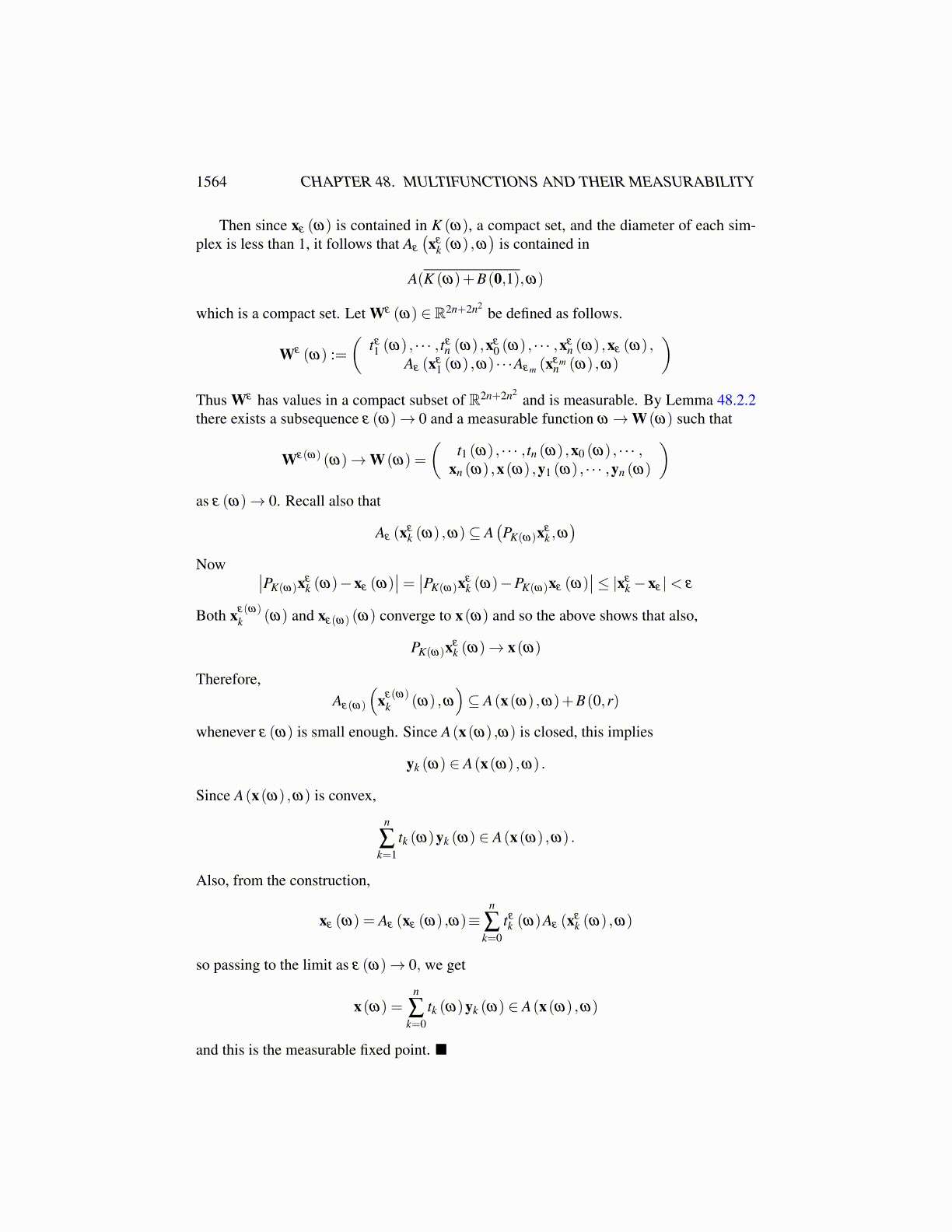
1564 CHAPTER 48. MULTIFUNCTIONS AND THEIR MEASURABILITY
a similar statement for Ĉ, it follows that B̂ε(ω)
(xε(ω)
k (ω) ,ω)= θ (ω)∗ i(ω)∗wε(ω)B
k (ω)
is within r of the closed convex bounded set B̂(x(ω) ,ω) whenever ε (ω) is small enough,similar for Ĉ. Thus
θ (ω)∗ i(ω)∗wBk (ω) ∈ B̂(x(ω) ,ω) ,
similar for Ĉ. Since this last set is convex, it follows that
θ (ω)∗ i(ω)∗∑k
tk (ω)wBk (ω) ∈ B̂(x(ω) ,ω)
similar for Ĉ.Now recall 48.3.9 and the inequality 48.3.12 which imply that for z ∈ θ (ω)−1 K (ω) ,(y(ω)−θ (ω)∗ i(ω)∗
(n
∑k=0
tk (ω)wBk (ω)+
n
∑k=0
tk (ω)wCk (ω)
),z−x(ω)
)(48.3.14)
= limε(ω)→0
(y(ω)−
(∑
nk=0 tε(ω)
k (ω)θ (ω)∗ i(ω)∗wε(ω)Bk (ω)
+∑nk=0 tε(ω)
k (ω)θ (ω)∗ i(ω)∗wε(ω)Ck (ω)
),z−xε(ω) (ω)
)
= limε(ω)→0
y(ω)−
∑nk=0 tε(ω)
k (ω) B̂ε(ω)
(xε(ω)
k ,ω)
+∑nk=0 tε(ω)
k (ω)Ĉε(ω)
(xε(ω)
k ,ω) ,z−xε(ω) (ω)
Recall 48.3.11 and 48.3.13 which imply from the above conventions that the sum in theabove equals B̂ε(ω)
(xε(ω),ω
)+Ĉε(ω)
(xε(ω),ω
). Thus the above equals
limε(ω)→0
(y(ω)−
(B̂ε(ω)
(xε(ω),ω
)+Ĉε(ω)
(xε(ω),ω
)),z−xε(ω) (ω)
)≤ 0
Now wε(ω)Bk (ω) ∈ B
(θ (ω)xε(ω)
k (ω) ,ω)
and the weak uppersemicontinuity must then
imply that wBk (ω) ∈ B(θ (ω)x(ω) ,ω) , a similar statement holding for C. By convexity,
wB (ω)≡n
∑k=0
tk (ω)wBk (ω) ∈ B(θ (ω)x(ω) ,ω) ,
similar for C. Then from 48.3.14,(y(ω)−θ (ω)∗ i(ω)∗
(n
∑k=0
tk (ω)wBk (ω)+
n
∑k=0
tk (ω)wCk (ω)
),z−x(ω)
)=
(θ (ω)∗ i(ω)∗ (y(ω)− (wB (ω)+wC (ω))) ,z−x(ω)
)≤ 0
It follows that if x(ω)≡ θ (ω)x(ω) ,
⟨y(ω)− (wB (ω)+wC (ω)) ,θ (ω)z− x(ω)⟩ ≤ 0
each of x(ω),wB (ω) ,wC (ω)
are measurable and wB (ω)∈B(x(ω) ,ω) ,wC (ω)∈C (x(ω) ,ω) . Since θ (ω)z is a genericelement of K (ω) , this proves the theorem.
Obviously one could have any finite sum of operators having the same properties asB,C above and one could get a similar result.